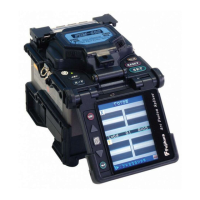
Do you have a question about the Fujikura FSM–60S and is the answer not in the manual?
| Type | Core Alignment |
|---|---|
| Applicable Fibers | SM, MM, DS, NZDS |
| Fiber Count | Single |
| Cladding Diameter | 125 µm |
| Typical Splice Loss (SM) | 0.02dB |
| Typical Splice Loss (MM) | 0.01dB |
| Typical Splice Loss (DS) | 0.04dB |
| Typical Splice Loss (NZDS) | 0.04 dB |
| Return Loss | ≥60dB |
| Splicing Time | 9 seconds |
| Electrode Life | 3000 splices |
| Operating Wavelength | 1310nm, 1550nm |
| Applicable Protection Sleeve Length | 40 mm, 60 mm |
| Storage of Splice Result | 2000 records |
| Operating Temperature | -10°C to +50°C |
| Storage Temperature | -40 to +80 °C |
| Display | LCD |
| Battery Life | 200 splices |
| Coating Diameter | 250 µm, 900 µm |
| Heating Time | 25 seconds |
Details general safety warnings, CAUTION, and WARNING symbols used in the manual.
Warns against removing the splicer protector and its potential consequences.
Covers electrical safety, power source usage, modification, and environmental hazards.
Specifies power source requirements, grounding, and proper cord connection for safety.
Illustrates correct fiber placement in V-groove and emphasizes correct cleave length and tension.
Explains how fiber angle and arc discharge stability affect splice loss.
Details AC power cord usage, grounding, generator precautions, and battery guidelines.
Explains inserting AC adapter/battery and AC operation precautions.
Explains connecting DC power cords and voltage/polarity precautions.
Details fiber cleaving steps and provides precautions for safe operation.
Guides on loading fiber with sheath clamp and handling memory curl.
Explains loading fiber using the fiber holder system and closing the wind protector.
Discusses arc discharge instability and interpreting splice point appearance.
Details fiber alignment, cleave angle check, and handling splice errors.
Describes arc discharge for splicing and the display of estimated splice loss.
Lists common causes of splice loss, such as core offset and bad end-face, with remedies.
Continues loss troubleshooting and explains how splicing results are stored.
Explains the importance of cleaning V-grooves and the procedure using cotton swabs or cleaved fiber.
Explains the procedure for cleaning objective lenses, including turning off the splicer.
Provides a detailed procedure for replacing the splicer electrodes.
Details the arc calibration process to regulate arc power and fiber splicing position.
Explains stabilizing electrodes and resetting the arc discharge count.
Provides guidance on interpreting error messages and solutions for fiber-related errors.
Lists solutions for errors related to dusty fibers and indistinct core fibers.
Provides solutions for motor overrun errors (Forward/Backward) for various motors.
Lists solutions for motor trouble, cover open errors, and focus errors.
Details solutions for errors like 'Cannot detect fiber', 'Strong Arc Power', and 'Fiber Separation'.
Lists solutions for errors related to cleave angle, fiber angle, cleave shape, and arc discharge.
Provides solutions for insufficient fiber cleaning and high estimated loss errors.
Lists solutions for errors related to dust in optical path, camera, heater, and sensor issues.
Addresses issues related to power supply, battery not turning off, and low splice count.
Covers inconsistent splice loss, monitor turning off, and method to initialize arc conditions.
Addresses incorrect splice mode selection, loss mismatch, and intermittent re-arc issues.